Project Overview
Information Products
Commodities
- Agronomic: grass (misc. perennial)
Practices
- Crop Production: biological inoculants
- Education and Training: workshop
- Natural Resources/Environment: hedges - grass
Proposal summary:
The project addresses a critical need for implementing more
windbreak solutions in arid southwest operations. Big sacaton is
the ideal for this: it is native, xeric, deep-rooting, tall and
productive. The project aims to provide quantitative data
necessary for agricultural stakeholders to practically implement
big sacaton windbreak solutions given their respective contexts
thereby advancing sustainable agriculture.
To this end, the project propagates 2500 big sacaton starts.
These are planted in five distinct types of hedges on two
separate farms. Two hedge types are dryland (3324' and 2292'
respectively). Three of them (1932', 1000', and 4000'
respectively) are watered on a "need-to" basis. Trade-offs
between watering and not-watering new hedges in terms of
survival, productivity, and soil biology over three years are
quantified. Altogether, the data provides a framework (time,
labor, costs) for planning and budgeting for establishing grass
windbreaks.
Moreover, ecological enhancements to soil, water and biodiversity
provided by each hedge are compared between each other. Soil
related enhancements are assessed via measurements of above and
below ground biomass, and by comparing root and compaction layer
depths. Enhancements to soil water holding capacity are assessed
by two indirect indicators for soil structure: soil water
infiltration rates, fungi and bacteria biomasses.
Biodiversity linked enhancements are evaluated by comparing the
functional diversity of microorganisms making up the hedge's soil
food web with that found before the hedge installation.
The project is a balance of research and education. The latter
comprises yearly hands on workshops, peer-to-peer stakeholder
learning meet-ups, journalistic blog posts and a video. The
events are held each year around key phases of the process of
establishing grass hedges. Events and Research findings are
disseminated each year through targeted outreach (NM Healthy
Soils 1800+ subscriber mailing list, social media) ensuring broad
dissemination among agricultural stakeholders in the area.
Project objectives from proposal:
Research Objectives:
- Determine a budget and planning framework for establishing
wind erosion hedges in semi-arid, USDA hardiness zone 6A,
variable rainfall (5-13"), degraded pinon-juniper grassland
plains (6000–7000ft. elevation). - Assess the trade-offs in survivorship, productivity and speed
of hedge establishment between dryland and irrigated hedges. - Enhance biomass and diversity of fungi and protozoa in the
soil surrounding big sacaton roots through the application of
biological inoculants in order to improve soil structure.
Education Objectives:
- Facilitate networking opportunities on sustainable
agriculture combined with hands-on learning among producers,
agricultural professionals, and interested individuals by hosting
yearly workshops. - Encourage through NM Healthy Soil blog posts the
establishment of wind erosion hedges on farms using easily
cultivable native warm-season prairie grass, aiming to create
ecological benefits. Disseminate data on ecological benefits of
big sacaton at the two project sites. - Facilitate collaboration and raise interest in integrating
microscope assessments to support sustainable and regenerative
agricultural practices. Provide training in microscopy for soil
health applications through peer-to-peer learning involving
concerned stakeholders.
